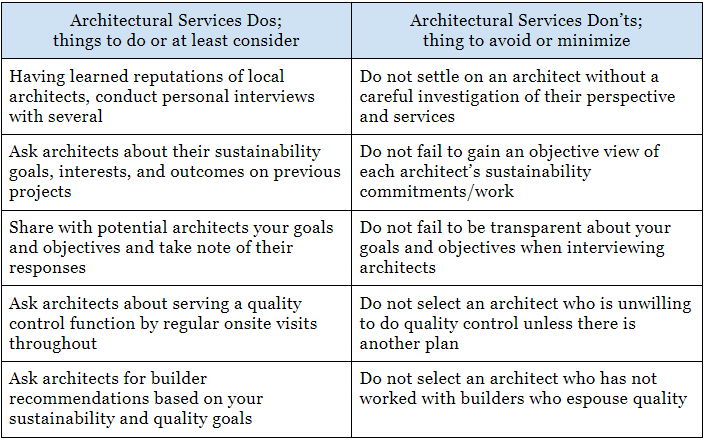Chapter 3
Do’s and Don’ts of Sustainable Housing
Opening Questions
Is there a road map to guide decisions about building a sustainable home?
What are the things I should be sure to do, or at least consider?
What are the things I should avoid, or hope to minimize?
Can I achieve operational and livable sustainability?
What is the first step? How do I get started?
Introduction
Thank you for spending time with this resource; our team hopes you find the information both interesting and useful for your needs. We have offered many tips and best practices throughout the book, and in simple lists as Dos and Don’ts at the end of each topic. We are using this Epilogue to compile all those ideas into one final section, to organize the information sequentially as choices may be encountered, and to add new suggestions to fill in the gaps between the topics of the book. This is a metaphorical road map for those striving to reduce their ecological footprint and live more sustainably, most notably in their housing and transportation needs.
Conceiving the Project
Architectural Services
Site Selection and Architect Hire
Designing and Planning
Construction Phase
Post-Construction
Summary and Beyond Housing and Transportation
We hope this Epilogue provides a succinct reference and roadmap for those striving to build a sustainable home. We know this resource is not complete, as it is surely constrained by our own limited perspectives, experiences, and biases. Additionally, materials and technologies are evolving and adapting to new and dynamic realities in science and markets, suggesting that this list will need ongoing review and revision. Our team will continue to research this field and maintain an updated Epilogue on our companion website. The good news is that we can answer the highest order question of this book with confidence and empirical evidence: yes, it is possible to achieve operational sustainability in housing and transportation. This is not only possible, but also practical, with onsite renewable energy powering both home and household transportation. It is important to acknowledge that resources are consumed in the construction of any home, including for any renewable energy generation equipment; resources are also consumed in the manufacture of electric vehicles. However, the perspective taken here, in targeting primarily consumers in the United States, is that this new paradigm will shift consumers from higher to lower-impacting systems and practices. The great surprise–and fantastic news–from this book, is that this is achievable at the least cost financially, and the least damage to environmental resources.






